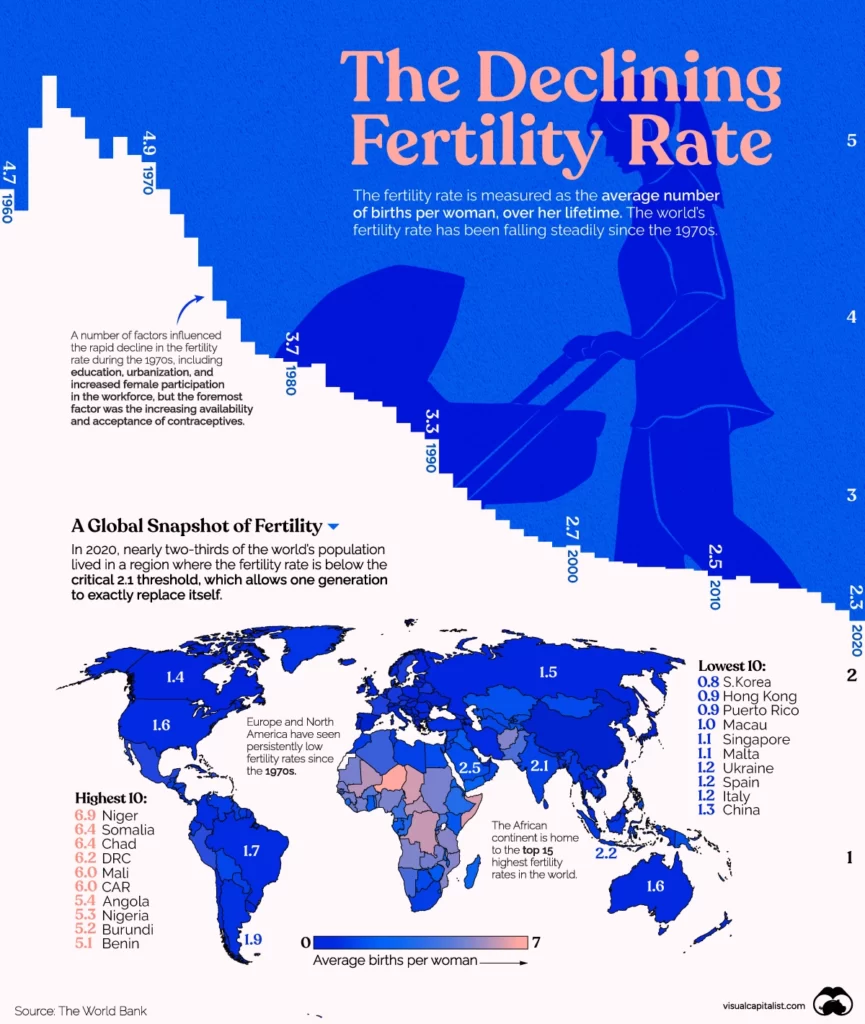Many think that the earth’s population is too high. “Limits to Growth”, published by the Club of Rome in 1972 concluded that the Earth, in view of population growth, food production, industrialisation and environmental pollution, was bound to collapse unless behaviours changed. E.g The first study underestimated the reserves of raw materials. The study was updated in 1992 and 2012 and most recently in 2022. The original Club of Rome report and other warnings of imminent environmental disaster encouraged environmentalists to believe that an environmentally sound society had to be a ‘no-growth society,’ and that achieving it had to become a priority everywhere in the world.

They predicted the birthrate would continue to climb exponentially and we would eat ourselves out of house and home.
Fifty years on, in 2022, the Club of Rome revised their projections and now focuses on sustainability. Projected population will peak at 8.8m says Club of Rome (Mar 2023), not 9.9 which is WHO estimate.
In the business-as-usual case, it foresees existing policies being enough to limit global population growth to below 9 billion in 2046 and then decline to 7.3 billion in 2100. Still too high.
If the world invested more in education and less inequality it estimates human numbers could hit a high of 8.5 billion as early as 2040 and then fall by more than a third to about 6 billion in 2100.
“Business as Usual” Is Unsustainable
- There are too many people
- Inequality of resources. 1 billion people consume 72% of the worlds resources. 1 billion consume just 1%. 6 billion consume the balance of 23%. In other words, 1 billion people consume 70 times more than the poor 1%.
- Not enough energy – there are over 1 billion people in energy poverty. 1 billion people have access to 70% of the energy produced, and 1 billion people have just 10% of energy
- Burning too much fossil fuel has driven anthropomorphic climate change. Exceeding 150C will result in a forecast billion people who will become climate refugees.
- Not enough food. A measure GHI shows over 826 with regular access to adequate nutrition. The number of people obese is now greater than the number of starving people. Food production has increased more than the global population and agricultural land. Animals eat this food, and then humans eat the animals.
- Loss of 68% of vertebrates species between 1970 and 2016
- Loss of half of the global forests since 1970 – mostly to agriculture and farming for animals.
- Running out of freshwater by 2030

This article will only deal with the number of people.
Sub Replacement Fertility
Wikipedia has a good explanation at https://en.wikipedia.org/wiki/Sub-replacement_fertility. The United Nations Population Division defines sub-replacement fertility as any rate below approximately 2.1 children born per woman of childbearing age, but the threshold can be as high as 3.4 in some developing countries because of higher mortality rates.[1] Translate a rate of 2.33 as 2 children per woman to replace the parents, plus a “third of a child” to make up for the higher probability of males born and mortality prior to the end of a person’s fertile life.
- In 1947, the global rate = 4.7 children per woman
- 2003 = 2.33
- 2020 = 2.4
- All of Europe, USA, Canada, Japan, Korea, Australia, is under 2
- South Korea is the lowest at 0.8
- Japan’s population will go from 126 million population in 2020, 107m by 2040, 97m by 2050 and 70m by 2100


Rebuttal of Earth’s Population is Too High and Peak births
In the 2011 -2013 period Dr Hans Rosling, a Swedish physician became popular by explaining facts about population. His analysis suggests the primary break to population is the education of women.
Worth the time to watch this. While it is over 10 years old, it has value in perspective.
Watch here: https://youtu.be/FACK2knC08E?si=_Af2Q0QFf8RyP8s0
DON’T PANIC — Hans Rosling showing the facts about population https://youtu.be/FACK2knC08E?si=_Af2Q0QFf8RyP8s0
Latest Discussion (late 2023)
In the World in 2100, Visual Capitalist demonstrates the divergence assumptions and how the expected population can range from 6 billion to 15b. What is the most likely? Not the UN projections but the Institute for Health Metrics and Evaluation (IHME), and the International Institute for Applied Systems Analysis (IIASA) provide more likely scenarios.
These differences may seem small, but even a few decimal places can have a huge impact. Increasing GDP per capita in Sub-Saharan Africa has climbed from $632 in 2000, to $1,690 in 2022, and this reduces birthrates substantially.


More Reading
- Word in 2100 https://www.visualcapitalist.com/when-will-the-global-population-reach-its-peak/





